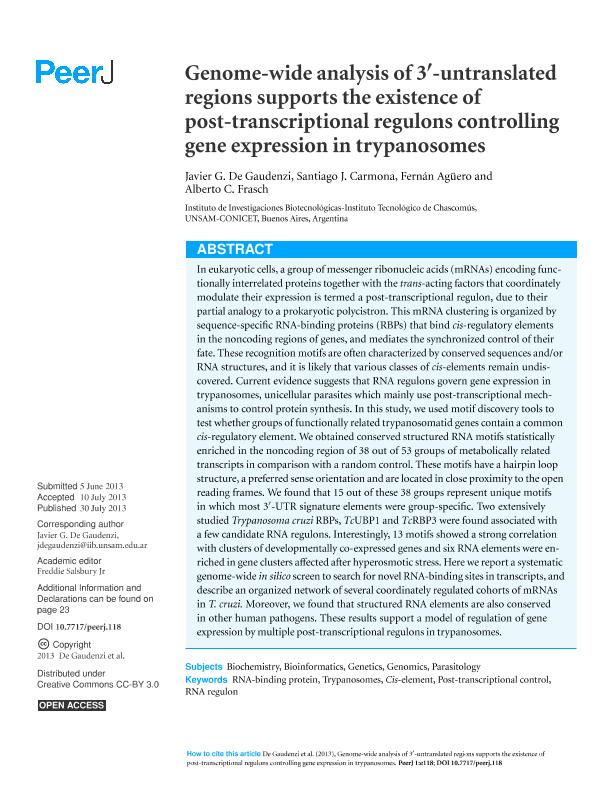Mostrar el registro sencillo del ítem
dc.contributor.author
de Gaudenzi, Javier Gerardo

dc.contributor.author
Carmona, Santiago Javier

dc.contributor.author
Agüero, Fernan Gonzalo

dc.contributor.author
Frasch, Alberto Carlos C.

dc.date.available
2017-09-21T20:06:10Z
dc.date.issued
2013-07-30
dc.identifier.citation
de Gaudenzi, Javier Gerardo; Carmona, Santiago Javier; Agüero, Fernan Gonzalo; Frasch, Alberto Carlos C.; Genome-wide analysis of 30 -untranslated regions supports the existence of post-transcriptional regulons controlling gene expression in trypanosomes; PeerJ Inc; PeerJ; 1; e118; 30-7-2013; 1-28
dc.identifier.issn
2167-8359
dc.identifier.uri
http://hdl.handle.net/11336/24839
dc.description.abstract
In eukaryotic cells, a group of messenger ribonucleic acids (mRNAs) encoding functionally interrelated proteins together with the trans-acting factors that coordinately modulate their expression is termed a post-transcriptional regulon, due to their partial analogy to a prokaryotic polycistron. This mRNA clustering is organized by sequence-specific RNA-binding proteins (RBPs) that bind cis-regulatory elements in the noncoding regions of genes, and mediates the synchronized control of their fate. These recognition motifs are often characterized by conserved sequences and/or RNA structures, and it is likely that various classes of cis-elements remain undiscovered. Current evidence suggests that RNA regulons govern gene expression in trypanosomes, unicellular parasites which mainly use post-transcriptional mechanisms to control protein synthesis. In this study, we used motif discovery tools to test whether groups of functionally related trypanosomatid genes contain a common cis-regulatory element. We obtained conserved structured RNA motifs statistically enriched in the noncoding region of 38 out of 53 groups of metabolically related transcripts in comparison with a random control. These motifs have a hairpin loop structure, a preferred sense orientation and are located in close proximity to the open reading frames. We found that 15 out of these 38 groups represent unique motifs in which most 30 -UTR signature elements were group-specific. Two extensively studied Trypanosoma cruzi RBPs, TcUBP1 and TcRBP3 were found associated with a few candidate RNA regulons. Interestingly, 13 motifs showed a strong correlation with clusters of developmentally co-expressed genes and six RNA elements were enriched in gene clusters affected after hyperosmotic stress. Here we report a systematic genome-wide in silico screen to search for novel RNA-binding sites in transcripts, and describe an organized network of several coordinately regulated cohorts of mRNAs in T. cruzi. Moreover, we found that structured RNA elements are also conserved in other human pathogens. These results support a model of regulation of gene expression by multiple post-transcriptional regulons in trypanosomes.
dc.format
application/pdf
dc.language.iso
eng
dc.publisher
PeerJ Inc
dc.rights
info:eu-repo/semantics/openAccess
dc.rights.uri
https://creativecommons.org/licenses/by-nc-sa/2.5/ar/
dc.subject
Rna-Binding Protein
dc.subject
Trypanosomes
dc.subject
Cis-Element
dc.subject
Post-Transcriptional Control
dc.subject
Rna Regulon
dc.subject.classification
Bioquímica y Biología Molecular

dc.subject.classification
Ciencias Biológicas

dc.subject.classification
CIENCIAS NATURALES Y EXACTAS

dc.title
Genome-wide analysis of 30 -untranslated regions supports the existence of post-transcriptional regulons controlling gene expression in trypanosomes
dc.type
info:eu-repo/semantics/article
dc.type
info:ar-repo/semantics/artículo
dc.type
info:eu-repo/semantics/publishedVersion
dc.date.updated
2017-09-14T13:55:38Z
dc.journal.volume
1
dc.journal.number
e118
dc.journal.pagination
1-28
dc.journal.pais
Estados Unidos

dc.journal.ciudad
Corte Madera
dc.description.fil
Fil: de Gaudenzi, Javier Gerardo. Consejo Nacional de Investigaciones Científicas y Técnicas. Centro Científico Tecnológico Conicet - La Plata. Instituto de Investigaciones Biotecnológicas. Instituto de Investigaciones Biotecnológicas "Dr. Raúl Alfonsín" (sede Chascomús). Universidad Nacional de San Martín. Instituto de Investigaciones Biotecnológicas. Instituto de Investigaciones Biotecnológicas "Dr. Raúl Alfonsín" (sede Chascomús); Argentina
dc.description.fil
Fil: Carmona, Santiago Javier. Consejo Nacional de Investigaciones Científicas y Técnicas. Centro Científico Tecnológico Conicet - La Plata. Instituto de Investigaciones Biotecnológicas. Instituto de Investigaciones Biotecnológicas "Dr. Raúl Alfonsín" (sede Chascomús). Universidad Nacional de San Martín. Instituto de Investigaciones Biotecnológicas. Instituto de Investigaciones Biotecnológicas "Dr. Raúl Alfonsín" (sede Chascomús); Argentina
dc.description.fil
Fil: Agüero, Fernan Gonzalo. Consejo Nacional de Investigaciones Científicas y Técnicas. Centro Científico Tecnológico Conicet - La Plata. Instituto de Investigaciones Biotecnológicas. Instituto de Investigaciones Biotecnológicas "Dr. Raúl Alfonsín" (sede Chascomús). Universidad Nacional de San Martín. Instituto de Investigaciones Biotecnológicas. Instituto de Investigaciones Biotecnológicas "Dr. Raúl Alfonsín" (sede Chascomús); Argentina
dc.description.fil
Fil: Frasch, Alberto Carlos C.. Consejo Nacional de Investigaciones Científicas y Técnicas. Centro Científico Tecnológico Conicet - La Plata. Instituto de Investigaciones Biotecnológicas. Instituto de Investigaciones Biotecnológicas "Dr. Raúl Alfonsín" (sede Chascomús). Universidad Nacional de San Martín. Instituto de Investigaciones Biotecnológicas. Instituto de Investigaciones Biotecnológicas "Dr. Raúl Alfonsín" (sede Chascomús); Argentina
dc.journal.title
PeerJ
dc.relation.alternativeid
info:eu-repo/semantics/altIdentifier/url/https://peerj.com/articles/118/
dc.relation.alternativeid
info:eu-repo/semantics/altIdentifier/doi/http://dx.doi.org/10.7717/peerj.118
Archivos asociados
